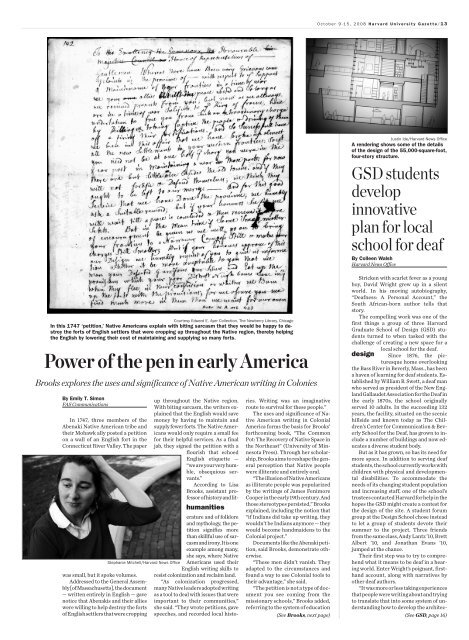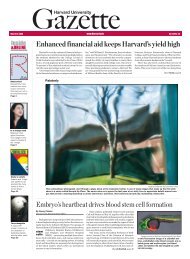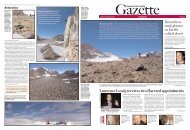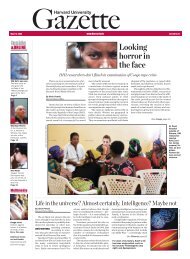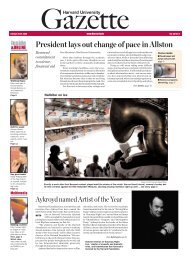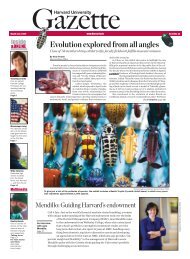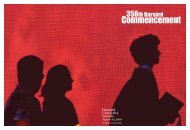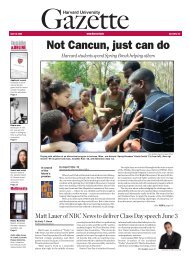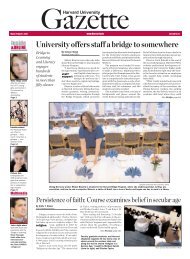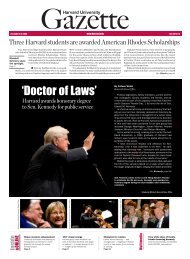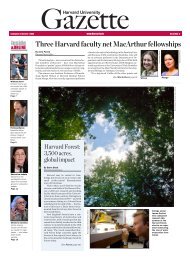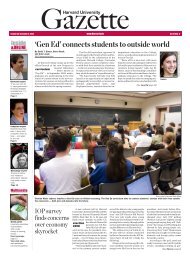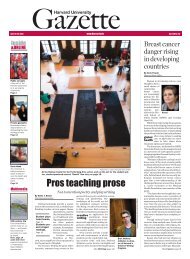12/ <strong>Harvard</strong> University Gazette Oc<strong>to</strong>ber 9-15, 2008Academy(Continued from previous page)grounding in the real world the social sciencesmight be, in the words of the AcademyWeb site, “left <strong>to</strong> the freefall of pure theory.”So in its 22 years, the academy has been achampion of combining the social scienceswith the real worlds of “area studies,” a termfor a scholarly immersion in the language,culture, and traditions of other societies.Since 1986, the academy has providedacademic shelter <strong>to</strong> nearly 100 promisingscholars — about 10 scholars for every twoyearcycle — in law, political science, psychology,his<strong>to</strong>ry, economics, sociology, andanthropology. Most academy scholars havebeen newly minted Ph.D.s or junior faculty atprestigious universities. All are students ofcultures and regions outside the West.“It takes courage <strong>to</strong> step outside your ownculture,” said academy executive officer (andscholar of French culture) Laurence H. Winnie.The scholars, he said, “are really pluggedin<strong>to</strong> these worlds.”The young researchers have worked in arange of languages, from Greek and Mandarin<strong>to</strong> Arabic and Twi (the main languageof Ghana, where Osseo-Asare has done muchof her work on African science). And manyhave lived “a year or two or three or seven inother countries,” including “some dangerousplaces,” said Winnie.Meanwhile, the scholars “bring a very immediatekind of reality,” he said. “They’rehere <strong>to</strong> assist <strong>Harvard</strong> in its intellectual enterprise.”One-time academy chairman Jorge I.Dominguez, now <strong>Harvard</strong>’s vice provost forInternational Affairs, called the decades-oldscholars program a “precursor” <strong>to</strong> the present<strong>Harvard</strong> push <strong>to</strong> encourage studyabroad. “It was an early affirmation of thevalue of work in other countries,” he said,“and now the rest of the University is catchingup <strong>to</strong> it.”Other <strong>Harvard</strong> venues embrace areastudies, said Timothy J. Col<strong>to</strong>n, a seniorscholar at the academy and the Morris andAnna Feldberg Professor of Government andRussian Studies. Those include the DavisCenter for Russian and Eurasian Studies,where he teaches, and the Fairbank Centerfor Chinese Studies, as well as the ReischauerInstitute of Japanese Studies. “But here,”Col<strong>to</strong>n said of area studies at the academy,“it’s privileged.”Mylonas, a recent Yale Ph.D. on leavefrom George Washing<strong>to</strong>n University, wouldagree.MRI(Continued from previous page)Jon Chase/<strong>Harvard</strong> <strong>News</strong> OfficeOsseo-Asare (right), who studies African medicinal plants, displays some alliga<strong>to</strong>r pepper seed pods, while undergraduate assistantCoral Rose Martin ’10 holds up some Hoodia teas.In his neat white-walled office on CambridgeStreet, the Greece-born political scientistdisplayed two vivid signs of privilege:time for culture and time <strong>to</strong> write. There wasa wall of calendar listings — “I integratewherever I am,” he said — and a computerscreen lined with text. (Mylonas is turningFor more on the <strong>Harvard</strong> Academy forInternational & Area Studies,www.wcfia.harvard.edu/academy/index.htmlhis dissertation in<strong>to</strong> a book.)Academy scholars take from <strong>Harvard</strong> — astipend, money for travel and research — andthey also give back, said Mylonas. They areresources for <strong>Harvard</strong> students still immersedin degree work. And their scholarshipis so new and their time abroad so recent,he said, that they “bring a fresh under-lung of people when upright and lying down.Walsworth said the current low-fieldMRI is the third generation of such instruments.In the late 1990s, his lab first built asmall version that worked on animals andfollowed that up in 2003 with a pro<strong>to</strong>type foruse on humans, developed <strong>to</strong>gether withcolleagues at the Brigham & Women’s Hospital,<strong>Harvard</strong> School of Public Health, andthe University of New Hampshire. The currentlow-field MRI incorporates changesbased on lessons from the earlier machines.“We cobbled <strong>to</strong>gether the first two systemsmostly from parts already found in ourlabs,” Walsworth said. “The current versionis the first <strong>to</strong> be optimally designed and employcus<strong>to</strong>m hardware.”In talking about the new technology,Walsworth reels off a list of people for whomit would be useful, including those withmagnet-sensitive pacemakers, prematurebabies with problems of lung function, andobese patients for whom getting inside a traditionalMRI might be difficult. He alsospoke of future possibilities, where a hyperpolarizedliquid or nanoparticles could bedeveloped for injection, then letting theMRI image the circula<strong>to</strong>ry system or findprecancerous lesions.Though there may eventually be otherapplications, the promise of a new kind oflung imaging has researchers taking notice.Jose Venegas, associate professor ofanaesthesia at <strong>Harvard</strong> Medical School andMGH, conducts research in<strong>to</strong> asthma’s effectson the lung and is interested in the lowfieldMRI’s capabilities. Venegas said theyoften use PET, or positron emission <strong>to</strong>mography,<strong>to</strong> image lungs, but because it is radiation-basedtechnology, there is a limit <strong>to</strong>how often the patient can be exposed.“Being able <strong>to</strong> study a subject multipletimes would be very useful in seeing howasthma develops, seeing the bronchial restrictions,”Venegas said.Venegas said the new low-field MRIcould also be useful in watching how lungfunction changes as a patient shifts position,going from a sitting <strong>to</strong> lying position.“I’ve taken a look at some of the data; it’svery impressive,” Venegas said. “I’m intriguedby the possibilities.”Rosen said he’d like <strong>to</strong> move the new machinefrom the CfA <strong>to</strong> MGH’s Martinos Center.They have the lab space, he said, but theyare still searching for funding <strong>to</strong> makechanges <strong>to</strong> the space the new equipment willrequire. Once it moves in, Rosen said, theywill begin <strong>to</strong> explore the possibilities of thenew technology.“One of the areas of research will be <strong>to</strong> reallyunderstand the role it may play,” Rosensaid. “I think it will have lots of applications.”Rosen called the work “a combination ofclever physics and physiology,” and said itisn’t the first time an imaging collaborationoccurred between <strong>Harvard</strong> medical imagersand astrophysics. The Astronomical Medicineproject at the IIC uses the expertise ofmedical imaging on sky surveys and otherstanding of what’s going on in the world.”Osseo-Asare ’98, Ph.D. 2005 — a his<strong>to</strong>rianof science on leave from the University ofCalifornia, Berkeley — is using part of hersecond year as an academy scholar <strong>to</strong> finisha book. It’s on plant-based traditionalAfrican remedies, the African scientists investigatingthem, and the potential the remedieshave for awakening pharmaceuticalmarkets on the continent.The program “is a real gift,” she said — noteaching obligations, “absolute freedom,(and) all the support we need <strong>to</strong> write and<strong>create</strong> what we’ve come <strong>to</strong> do.”Osseo-Asare’s book will explore five traditionalmedicines — from Ghana, SouthAfrica, and Madagascar — that addressleukemia, malaria, cardiac health, impotence,and appetite disorders. She’s also achampion of scholars using digital audio andvideo in their research — a fieldwork approachshe is now employing in a parallelstudy of science policy in Ghana.The <strong>Harvard</strong> Academy supports youngscholars whose work may only later bearpractical fruit, said Osseo-Asare.Its mission also acknowledges that theacademic world sometimes sidesteps the scientificachievements of non-Western cultures.That’s a blindness that never affected her,said Osseo-Asare, whose father — born inGhana — is a professor of metals science atPenn State. Two of his close academic friendsare a mathematician from Rwanda and achemist from Nigeria.It’s a cultural blindness that the <strong>Harvard</strong>Academy is addressing <strong>to</strong>o. Without suchfixes, said Osseo-Asare, “There’s a wholeclass of people missing from the literature.”corydon_ireland@harvard.eduastronomical projects.Walsworth cited a collaboration with the<strong>Harvard</strong> Center for Brain Science onnanoscale magnetic sensing as another casewhere new bioimaging <strong>to</strong>ols are being developedby physical and life scientists working<strong>to</strong>gether.“We plan <strong>to</strong> keep pushing the boundariesof what can be measured and imaged andthen applying these new <strong>to</strong>ols in both thephysical and life sciences,” Walsworth said.Collaborations such as these, Rosen said,illustrate the benefit of working at a large researchinstitution such as <strong>Harvard</strong>, whereadvances in one field can benefit other fields,even though they are seemingly unrelated.“The interesting thing is all of these connectionsbetween basic physics, way-outcosmology, patient care, computers, andtechnology,” Rosen said. “The same physicsused <strong>to</strong> solve mysteries of the universe canbe applied <strong>to</strong> these here-on-Earth problems.”alvin_powell@harvard.edu
Oc<strong>to</strong>ber 9-15, 2008 <strong>Harvard</strong> University Gazette/ 13Courtesy Edward E. Ayer Collection, The Newberry Library, ChicagoIn this 1747 ‘petition,’ Native Americans explain with biting sarcasm that they would be happy <strong>to</strong> destroythe forts of English settlers that were cropping up throughout the Native region, thereby helpingthe English by lowering their cost of maintaining and supplying so many forts.Power of the pen in early AmericaBrooks explores the uses and significance of Native American writing in ColoniesBy Emily T. SimonFAS CommunicationsIn 1747, three members of theAbenaki Native American tribe andtheir Mohawk ally posted a petitionon a wall of an English fort in theConnecticut River Valley. The paperStephanie Mitchell/<strong>Harvard</strong> <strong>News</strong> Officewas small, but it spoke volumes.Addressed <strong>to</strong> the General Assembly[of Massachusetts], the document— written entirely in English — gavenotice that Abenakis and their allieswere willing <strong>to</strong> help destroy the fortsof English settlers that were croppinghumanitiesup throughout the Native region.With biting sarcasm, the writers explainedthat the English would savemoney by having <strong>to</strong> maintain andsupply fewer forts. The Native Americanswould only require a small feefor their helpful services. As a finaljab, they signed the petition with aflourish that echoedEnglish etiquette —“we are your very humble,obsequious servants.”According <strong>to</strong> LisaBrooks, assistant professorof his<strong>to</strong>ry and literatureand of folkloreand mythology, the petitionsignifies morethan skillful use of sarcasmand irony.It is oneexample among many,she says, where NativeAmericans used theirEnglish writing skills <strong>to</strong>resist colonization and reclaim land.“As colonization progressed,many Native leaders adopted writingas a <strong>to</strong>ol <strong>to</strong> deal with issues that wereimportant <strong>to</strong> their communities,”she said. “They wrote petitions, gavespeeches, and recorded local his<strong>to</strong>ries.Writing was an imaginativeroute <strong>to</strong> survival for these people.”The uses and significance of NativeAmerican writing in ColonialAmerica forms the basis for Brooks’forthcoming book, “The CommonPot: The Recovery of Native Space inthe Northeast” (University of MinnesotaPress). Through her scholarship,Brooks aims <strong>to</strong> reshape the generalperception that Native peoplewere illiterate and entirely oral.“The illusion of Native Americansas illiterate people was popularizedby the writings of James FenimoreCooper in the early 19th century. Andthose stereotypes persisted,” Brooksexplained, including the notion that“if Indians did take up writing, theywouldn’t be Indians anymore — theywould become handmaidens <strong>to</strong> theColonial project.”Documents like the Abenaki petition,said Brooks, demonstrate otherwise.“These men didn’t vanish. Theyadapted <strong>to</strong> the circumstances andfound a way <strong>to</strong> use Colonial <strong>to</strong>ols <strong>to</strong>their advantage,” she said.“The petition is not a type of documentyou see coming from themissionary schools,” Brooks added,referring <strong>to</strong> the system of educationJustin Ide/<strong>Harvard</strong> <strong>News</strong> OfficeA rendering shows some of the detailsof the design of the 55,000-square-foot,four-s<strong>to</strong>ry structure.GSD studentsdevelopinnovativeplan for localschool for deafBy Colleen Walsh<strong>Harvard</strong> <strong>News</strong> OfficeStricken with scarlet fever as a youngboy, David Wright grew up in a silentworld. In his moving au<strong>to</strong>biography,“Deafness: A Personal Account,” theSouth African-born author tells thats<strong>to</strong>ry.The compelling work was one of thefirst things a group of three <strong>Harvard</strong>Graduate School of Design (GSD) studentsturned <strong>to</strong> when tasked with thechallenge of creating a new space for adesignlocal school for the deaf.Since 1876, the picturesquehome overlookingthe Bass River in Beverly, Mass., has beena haven of learning for deaf students. Establishedby William B. Swett, a deaf manwho served as president of the New EnglandGallaudet Association for the Deaf inthe early 1870s, the school originallyserved 10 adults. In the succeeding 132years, the facility, situated on the scenichillside and known <strong>to</strong>day as The Children’sCenter for Communication & BeverlySchool for the Deaf, has grown <strong>to</strong> includea number of buildings and now educatesa diverse student body.But as it has grown, so has its need formore space. In addition <strong>to</strong> serving deafstudents, the school currently works withchildren with physical and developmentaldisabilities. To accommodate theneeds of its changing student populationand increasing staff, one of the school’strustees contacted <strong>Harvard</strong> for help in thehopes the GSD might <strong>create</strong> a contest forthe design of the site. A student forumgroup at the Design School chose instead<strong>to</strong> let a group of students devote theirsummer <strong>to</strong> the project. Three friendsfrom the same class, Andy Lantz ’10, BrettAlbert ’10, and Jonathan Evans ’10,jumped at the chance.Their first step was <strong>to</strong> try <strong>to</strong> comprehendwhat it means <strong>to</strong> be deaf in a hearingworld. Enter Wright’s poignant, firsthandaccount, along with narratives byother deaf authors.“It was more or less taking experiencesthat people were writing about and trying<strong>to</strong> translate that in<strong>to</strong> some system of understandinghow <strong>to</strong> develop the architec-(See Brooks, next page) (See GSD, page 16)


